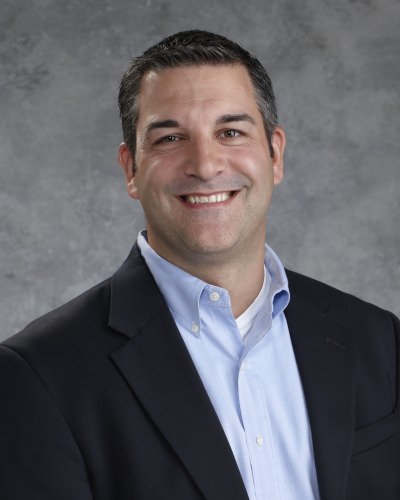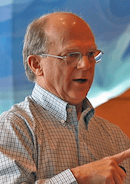WARF program leader: Sale marks success for UW-Madison research prowess, creativity
The recent sale of a UW–Madison spinoff that promises to increase efficiency and reduce antibiotic use in making fuel ethanol marks a victory for UW–Madison technology, says Greg Keenan, manager of the Accelerator Program (AP) at the Wisconsin Alumni Research Foundation.
AP is designed to make it easier for companies to license patents held by WARF, including the one for advanced ethanol production.
The spinoff, Lactic Solutions LLC, was bought on Oct. 23 by Lallemand Biofuels & Distilled Spirits, a unit of Lallemand Inc.

Greg Keenan, who has spent a career advancing technology in Madison and Cambridge Mass., pilots an innovative program at Wisconsin Alumni Research Foundation that helps bridge the gap between research funding and licenses for UW–Madison inventions. WARF
“Lactic Solutions is thrilled to be joining the Lallemand team,” said Jim Steele, a professor of food science and co-founder of Lactic Solutions. “It is our dream to take technology developed in our university research laboratories and turn it into products that reduce reliance on antibiotics and enhance yields in ethanol biorefineries. Lallemand has all the pieces we were trying to build.”
The company’s patent protects bioengineered bacteria that normally make lactic acid, a contaminant in ethanol plants. Instead of killing these bacteria, Steele inserted genes that cause them to make ethanol, converting a problem into an asset.
But having a great idea was only the start, Steele says. “The programs available at the University of Wisconsin–Madison were essential to our success. They provided expertise we didn’t even know we needed, as well as research funding.”
The Great Lakes Bioenergy Research Center funded Steele’s original research. Discovery to Product helped refine the business plan, and WARF’s Accelerator Program supplied funding to bridge between research grants and licensing. “The Accelerator Program made all the difference,” says Steele, “as it enabled us to move a concept into a prototype that we could demo to potential partners.”
That is exactly what AP is supposed to do, says Keenan. “WARF has a long record of licensing inventions in our patent portfolio, but many of those great new ideas need a boost to attract a successful license.”
AP’s five concentrations represent some of the most vigorous segments of UW–Madison inventiveness, and thus of WARF’s patent portfolio: Biopharmaceuticals, clean technology, computer science and engineering, food and agriculture, and medical devices and lab diagnostics.
Ideas get on AP’s radar when a campus inventor “discloses” an invention to WARF, which is the first step in deciding whether to file a patent.
AP’s goal is removing some risk from some of the promising intellectual property in WARF’s portfolio, regardless of whether the patent has been issued. Businesses, Keenan explains, are reluctant to invest in untested technology, no matter how promising. “We ask, does this technology solve a problem that a customer cares about? Is the market big enough? We look for ideas where we think some money will increase the value by allowing a demonstration of the technology.”
AP funding generally pays for a prototype, field trial, efficiency study or toxicology screening. “Throughout the process we are trying to validate the business case: Does it perform?” Keenan explains. “We are trying to nudge the technology along so it can reach a commercial milestone that makes it easier to understand and buy.”
The AP program, along with other innovations like equity investment in startups, represents a broadening of WARF’s original role. From its roots as the nation’s first university patent-licensing organization, WARF has recognized the need to guide and encourage startups, and invest in them.
The 97 AP projects to date have produced 26 commercial agreements, Keenan says. AP annually invests $2 million to $2.5 million in active projects; with grants that range from $5,000 to $200,000 apiece.
Keenan brings 20 years of experience in commercializing new technology to a job that offers assistance to a cornucopia of technologies.
“I have worked at a range of companies, large and small, in a variety of industries: chemicals, material science, energy and agriculture,” he says. “I’m excited to take those years of commercialization experience and apply it to the intellectual property coming out of UW–Madison. There is no shortage of great ideas here.”
A key element of AP is the Catalyst program, says Keenan. “We provide a group of industry experts, called catalysts, who work with us and the principal investigator to identify what commercial milestones we should be talking about. The PIs tell us the catalysts are really helpful in connecting to industry folks.”
One catalyst is Christopher Salm, co-founder of Salm Partners LLC, which produces hot dogs and sausages and is an industry leader in developing new technology systems for processing meats. Salm, winner of the 2016 entrepreneur of the year award from the College of Agriculture and Life Sciences, says “Catalysts are one way of evaluating proposals for their potential to impact the world, to get various perspectives that come from many different experiences. It’s not about revising the science as much as the ‘Aha!’ of a marketplace application. We do that by assembling a group of experienced business people.”
In some cases, Salm says, the solution may require a change of focus: ‘What if we take this technology and apply it over there? Could that produce value in the marketplace?’”
Although WARF’s patent-and-license business plan has prospered for more than 90 years (the organization is providing $61.9 million for the 2017-18 academic year to support research and activities at UW–Madison), the only constant in life is change, and giving guidance and grants through AP is a necessary change of strategy, Keenan says. “We are trying to give visibility, life to more technologies. Companies want see more proof points, and so we help fill out the picture and show how it is going to impact their business.”
Tags: entrepreneurship, outreach, spinoffs, WARF





